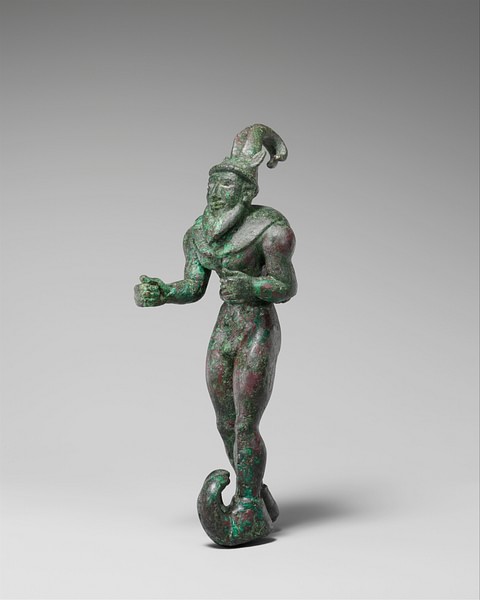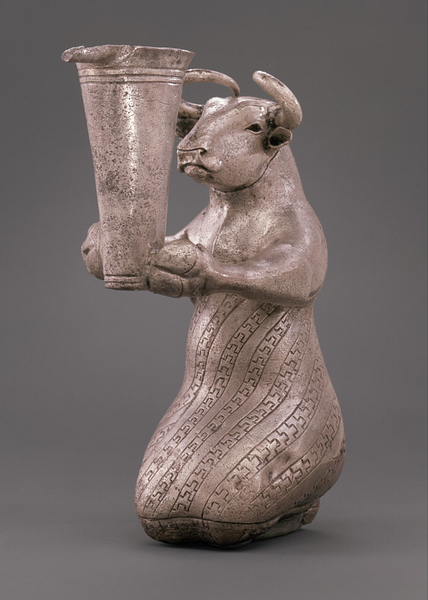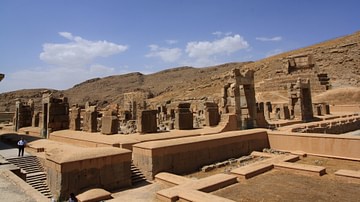Elam, located in the region of the modern-day provinces of Ilam and Khuzestan in Iran, was one of the most impressive civilizations of the ancient world. It was never a cohesive ethnic kingdom or polity but rather a federation of different tribes governed at various times by cities such as Susa, Anshan, and Shimashki until it was united during the Middle Elamite Period, briefly, as an empire. The name Elam was given to the region by others – the Akkadians and Sumerians of Mesopotamia – and is thought to be their version of what the Elamites called themselves – Haltami (or Haltamti) – meaning "those of the high country". 'Elam', therefore, is usually translated to mean "highlands" or "high country" as it was comprised of settlements on the Iranian Plateau which stretched from the southern plains to the elevations of the Zagros Mountains. The Bible's claim from Genesis 10:22 that the land was named for Elam, son of Shem, son of Noah has no support outside of the biblical narrative.

The Elamites were most likely the indigenous people of the region whose civilization began to develop about the same time as the Mesopotamian Ubaid Period (c. 5000-4100 BCE). They had built Susa, one of the oldest cities in the world, and developed a script by c. 3200 BCE toward the end of the Predynastic Period in Egypt (c. 6000 to c. 3150 BCE), centuries before the pyramids of Giza were erected. Their history is divided into four periods by modern-day scholars:
- Proto-Elamite Period (c. 3200 to c. 2700 BCE)
- Old Elamite Period (c. 2700 to c. 1600 BCE)
- Middle Elamite Period (c. 1500 to c. 1100 BCE)
- Neo-Elamite Period (c. 1100 to c. 539 BCE)
These periods trace the development of the Elamite civilization from its earliest known existence through its progress and down to its decline and assimilation but too often omit the significant contributions it made to the culture of the Near East and the rest of the world. Elam was a central participant in the history of the Near East between c. 3200 - c. 539 BCE. It fought with Sumer, was conquered by the Akkadian Empire, allied with and was betrayed by Hammurabi of Babylon, founded its own empire, helped topple the great Neo-Assyrian Empire, and was finally absorbed by the Achaemenid Empire c. 539 BCE, after which Elamite culture continued to exert a significant influence.
The artisans of the early Proto-Elamite Period were unparalleled in their era, women's equality was recognized as was the legitimacy of differing religious beliefs, and the cultures of other civilizations were respected, even when the Elamites were at war with them.
Below are ten important facts concerning the ancient Elamites who, although they disappeared completely from the historical record after their last nation-state, Elymais, was taken by the Sassanian Empire in 224 CE, left their mark on history through their contributions to Persian culture.
Script Remains Undeciphered
The Elamite linear script, which documents their history c. 3200-2700 BCE, remains undeciphered. Their language has no known relatives (therefore is designated a language isolate), and no artifact comparable to the famous Rosetta Stone has yet appeared to facilitate translation. When Elam came into closer contact with Sumer and, later, with Akkad, it adopted cuneiform script for its records and correspondence. Elamite continued to be written using cuneiform from c. 2700 BCE until it vanished c. 224 CE. The Achaemenid Empire (c. 550-330 BCE) made use of cuneiform Elamite script and Darius I (the Great, r. 522-486 BCE) used Elamite as one of the three languages of his famous Behistun Inscription but, until someone translates the earlier linear script, events of the Proto-Elamite Period will remain unknown.
First War in Recorded History
An example of what is lost because of the undeciphered script is the relationship between Elam and Sumer during this period and the events which led up to the first war in recorded history. Around 2700 BCE, the Sumerian king Enmebaragesi of the city-state of Kish launched a campaign against Elam, won a great victory, and carried the spoils back to Sumer. This event is known from the Sumerian King List, which is notorious for its tantalizingly brief entries, and the event is not elaborated on elsewhere. The Elamites, having lost the war, understandably felt no great compulsion to record it in cuneiform afterwards.
Completely Unique Artwork
Early Elamite artwork is also missing an accompanying written narrative which might shed light on the origins of their entirely novel artwork. Ceramics, jewelry, impressions, and metalwork of the Proto-Elamite Period corresponds to no other civilization's in the region nor, in fact, in the world of that era. Scholars have noted how other civilizations of the time – Sumerian, Akkadian, Egyptian, etc. – prioritized human figures in their art or anthropomorphized animals (as with the Egyptian practice of combining, say, the head of a cat with the body of a woman to depict the goddess Bastet) while the Elamites made animals the focus of their art. Animals, especially dogs, appear in reliefs found at Susa in place of human beings, possibly as human stand-ins in telling a legend or myth. Among the most famous artworks of this period is the piece known as Kneeling Bull Holding Vessel, created c. 3100 - c. 2900 BCE. The piece is a carefully crafted silver bull, kneeling, in an ornamented robe, holding what appears to be a drinking cup. After Elam came into closer contact with Sumer, their art reflected the new relationship and lost its originality but still exhibits a high level of skill.
Susa: The Ancient City
The Elamites built one of the most ancient cities in world history, Susa, which dates from c. 4200 BCE. Archaeological evidence confirms human habitation of the site dating to c. 7000 BCE with continuous settlement dating to 4395 BCE before the community built the city. It was an important center of trade during the Proto-Elamite Period, flourished during the Middle Elamite Period, and was given special attention by two of the greatest kings in Elamite history, Untash-Napirisha (r. c. 1275-1240 BCE) and Shutruk-Nahhunte (r. 1184-1155 BCE) who made Susa his capital. The city was known for impressive developments in agriculture, ceramics, metallurgy, and textiles. It became one of the capitals of the Achaemenid Empire and remained an important center for trade, commerce, industry, and the arts until it was destroyed by the Mongol Invasion of 1218 CE.
Practiced a Polytheistic Religion
The Elamite religion was polytheistic and, like the religions of other ancient civilizations, focused on deities who represented cosmic powers, regional concerns, and natural phenomena. The details of religious ritual and observance are not known, but sacred sites were established on mountains, high hills, and in sacred groves, and the focus of the rituals – based on inscriptions found primarily at Susa – was the immortality of the soul and the afterlife. The earliest religious artifacts suggest worship of a Mother Goddess who may have later become the goddess Kiririsha, Mother of the Gods and consort/wife to the gods Insushinak and Humban, patron gods of Susa and Anshan, respectively. The Elamite pantheon consisted of 200 separate deities, presided over by the supreme god Napirisha (Lord of the Earth and People) who seem to have been worshipped to greater or lesser degrees in different areas of Elam. The Elamites also incorporated Mesopotamian deities – particularly Sumerian – into their pantheon and so also worshipped Ea, Enki, Ninhursag, Shamash, and others.
Encouraged Religious Tolerance
These deities were worshipped all throughout the vast region of Elam which, at most times, comprised the southern areas of modern-day Iran and part of Iraq. There is no evidence, however, of compulsory worship imposed by a ruling house on the people, not even during the Middle Elamite Period when the rulers pursued a policy of "elamization" of the people and encouraged a standard of culture and religion. No records exist of religious strife, persecution, or any social unrest caused by differing modes of worship or focus on a single deity. This kind of tolerance would find full expression in the greatest Elamite building project still extant today: the temple complex of Dur-Untash.
Dur-Untash: The Great Temple
Among the most famous kings of the Elamites was the great Untash-Napirisha of the Igihalkid Dynasty (c. 1400 - c. 1200 BCE) during the Middle Elamite Period who built the ziggurat and temple complex of Dur-Untash (also known as Chogha Zanbil). Dur-Untash translates as "Fortress of Untash" (or "City of Untash", "Town of Untash") in Assyrian while the modern name for the site – Chogha Zanbil – translates as "basket mound" owing to its appearance as an upside-down basket. It was originally conceived as a monument to the patron god of Susa, Insushinak, and a ziggurat was constructed which was then torn down to realize an even grander vision: a temple complex for all the gods which would welcome worshippers from any region of Elam. The site featured a grand central ziggurat dedicated to Insushinak with eleven temples to other gods surrounded by three concentric walls with the entire structure rising five levels to a height of 174 feet (53 meters). Untash-Napirisha's temple epitomized the Elamite value of religious tolerance and was still under construction when the king died. It was abandoned afterwards for unknown reasons and seems to have never been actually used.
![Chogha Zanbil Ziggurat [East Side], Iran](https://www.worldhistory.org/img/r/p/500x600/10670.jpg?v=1702536009)
Respected Women's Equality
Women in Elamite culture are depicted in artwork as the equals of men. Reliefs show women and men at the same size and in an equal relationship with each other, which is how ancient artists rendered the concept of equality. In comparing Elamite art with, say, Egyptian reliefs or statuary, one can recognize this paradigm easily in that Egyptian art consistently emphasizes the status of a given figure in a piece by size. There are no written records (as there are with the Persians) giving a direct account of women's equality, but Elamite art attests to a level comparable to the well-known equality of Egyptian and, later, ancient Persian women. Among the best examples of this is the statue of the queen Napirasu, wife of Untash-Napirisha, which depicts the queen in the same royal attire as a male monarch. Cylinder seals also depict male and female figures, usually husband and wife, as equals.
Founded an Empire
The king Shutruk-Nakhkunte of the Sutrukid Dynasty (c. 1200 - c. 1100 BCE) began his reign by revitalizing, restoring, and ornamenting his cities, especially Susa, in order to establish Elam's grandeur and power and, afterwards, embarked on a campaign into Mesopotamia to fulfill that vision. Along with his sons, who served under him and would later become rulers of their own cities, he established the Elamite Empire. He is infamous in Mesopotamian history for sacking the city of Sippar and taking the statue of the god Marduk – which was on loan from Babylon – and then marching the length of the region of Babylonia conquering every city-state in his path. He sent the spoils of his conquest back to Susa and, among them, some of the most famous artifacts of Mesopotamian history such as the Victory Stele of Naram-Sin, celebrating the Akkadian victory over Elam, and the stele of Hammurabi of Babylon inscribed with his law code. Shutruk-Nakhkunte's empire would not survive beyond the reign of his youngest son due to infighting among family members.
Preservation & Influence on Culture
Through their interactions with Sumer, Elam absorbed – and then preserved – some of the Sumerians' most vital cultural aspects. Beginning in the Old Elamite Period, Elamite artisans began incorporating Sumerian motifs and techniques into their own work. Some of the best-known deities of the Sumerian pantheon were preserved by the Elamites and possibly aspects of their rituals, though this is speculative. The Elamites' own religious beliefs, deities, and rituals seem to have influenced the Early Iranian Religion of the region prior to the rise of Zoroastrianism which, of course, adopted a number of the early rituals to its own use. The concept of sacred spaces on high ground was an aspect of both the Early Iranian Religion and Zoroastrianism as were deities who personified cosmic or natural powers. In Zoroastrianism, these deities became aspects of the one god Ahura Mazda but, in the earlier polytheistic religion of the Iranians, they seem to have shared much in common with the Elamite deities as well as those of the Indus Valley. When Elam was absorbed into the Achaemenid Empire, their culture was adapted to Persian needs and values which would continue to develop from c. 550 BCE through 651 CE when the Persian Sassanian Empire fell to the Muslim Arabs. Afterwards, the Elamite-Persian culture would eventually be valued by the conquerors and disseminated throughout the Near East.

Conclusion
The Elamites were consistently either central or peripheral players in some of the most important events of the Near East between c. 2700 BCE - 224 CE although their civilization and contributions are often overlooked. At the height of their power, the Elamite monarchs were king-makers. Scholar Marc Van de Mieroop comments:
The [kings of Elam] received correspondence from Hammurabi of Babylon, Zimri-Lim of Mari, and others. They declared themselves to be his "sons" rather than his "brothers", the usual term when they corresponded with one another. To them he was "the great king of Elam". His armies placed rulers on thrones as far away as Shubat-Enlil in northern Syria. Elam's strength derived from the size of its state and the manpower it could summon. Contributing to its prominence was the fact that it controlled the flow of Iranian tin to the west after the end of [the river system of] Karum-Kanesh. This crucial ingredient for bronze production reached the Mediterranean from Elam via Mari. Elam was also in close contact with Dilmun in the Persian Gulf, so it may have monopolized access to other foreign resources and routes as well. (102-103)
Although they were conquered many times throughout their history, the Elamites persevered and maintained their culture and heritage. In the end, their assimilation into the Persian empires only furthered their vision in that it preserved essential Elamite values. Just as the Elamites had taken Sumerian artworks and other cultural aspects and made them their own, so the Persians appropriated Elamite culture for their own uses and, in doing so, preserved them.







